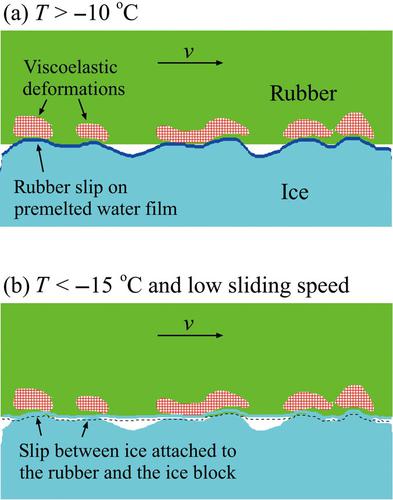Friction ( IF 6.3 ) Pub Date : 2023-01-06 , DOI: 10.1007/s40544-022-0715-5 Toshi Tada , Satoshi Kawasaki , Ryouske Shimizu , Bo N. J. Persson

|
We study the friction when a rectangular tire tread rubber block is sliding on an ice surface at different temperatures ranging from −38 to −2 °C, and sliding speeds ranging from 3 µm/s to 1 cm/s. At low temperatures and low sliding speeds we propose that an important contribution to the friction force is due to slip between the ice surface and ice fragments attached to the rubber surface. At temperatures above −10 °C or for high enough sliding speeds, a thin premelted water film occurs on the ice surface and the contribution to the friction from shearing the area of real contact is small. In this case the dominant contribution to the friction force comes from viscoelastic deformations of the rubber by the ice asperities. We comment on the role of waxing on the friction between skis and snow (ice particles).
中文翻译:

橡胶冰摩擦
我们研究了矩形轮胎胎面橡胶块在 −38 至 −2 °C 的不同温度和 3 µm/s 至 1 cm/s 的滑动速度下在冰面上滑动时的摩擦力。在低温和低滑动速度下,我们提出摩擦力的一个重要贡献是由于冰面和附着在橡胶表面的冰碎片之间的滑动。在 -10 °C 以上的温度或足够高的滑动速度下,冰表面会出现一层薄的预融化水膜,实际接触区域的剪切对摩擦力的贡献很小。在这种情况下,对摩擦力的主要贡献来自于冰粗糙体引起的橡胶粘弹性变形。我们评论了打蜡对滑雪板和雪(冰粒)之间摩擦的作用。











































 京公网安备 11010802027423号
京公网安备 11010802027423号